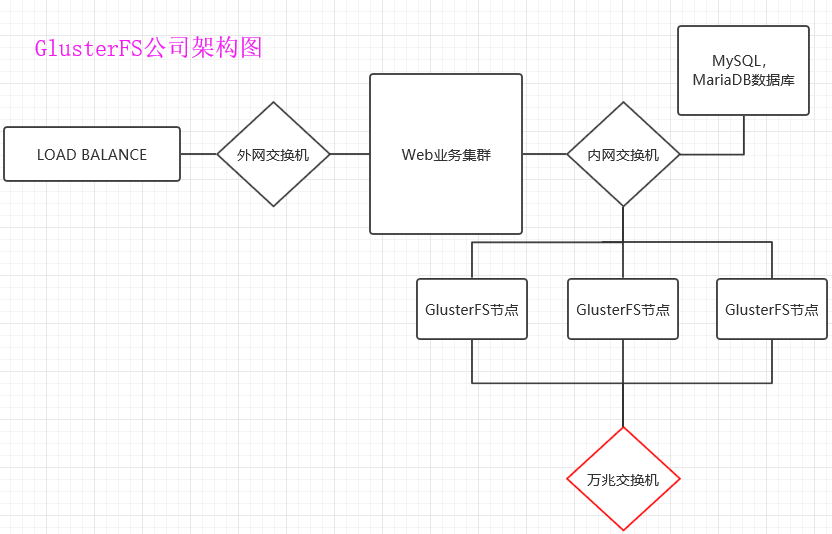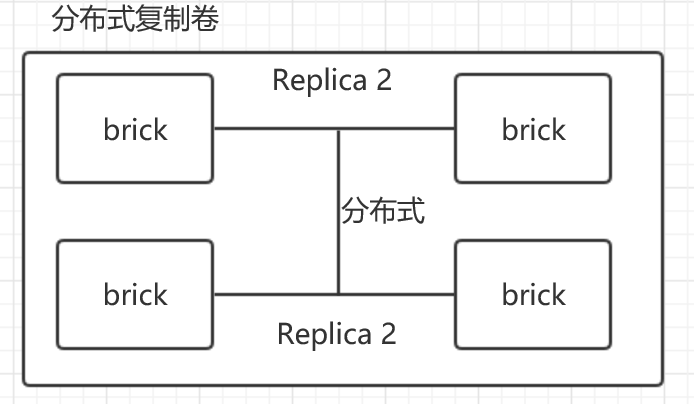@zhangsiming65965
2019-01-20T08:06:27.000000Z
字数 18576
阅读 210
GlusterFS分布式存储系统
云计算
---Author:张思明 ZhangSiming
---Mail:1151004164@cnu.edu.cn
---QQ:1030728296
如果有梦想,就放开的去追;
因为只有奋斗,才能改变命运;
一、分布式存储系统简介
1.1 分布式存储简介
计算机通过文件系统管理,存储数据,而现在数据信息爆炸的时代中人们可以获取的数据成指数倍的增长,单纯通过增加硬盘个数来扩展计算机文件系统的存储容量的方式,已经不能满足目前的需求,所以需要GlusterFS,分布式云存储
分布式存储好处:
分布式文件系统可以有效解决数据的存储和管理难题,将固定于某个地点的某个文件系统,扩展到任意多个地点/多个文件系统,众多的节点组成一个文件系统网络。每个节点可以分布在不同的地点,通过网络进行节点间的通信和数据传输。人们在使用分布式文件系统时,无需关心数据是存储在哪个节点上,或者是从哪个节点从获取的,只需要像使用本地文件系统一样管理和存储文件系统中的数据
1.2 NFS简介(Network File System)
NFS的特点:允许网络中的计算机通过TCP/IP网络共享资源,只需要挂在到NFS即可访问
优点:
- 节约使用的磁盘空间
- 节约硬件资源
- 用户主目录设定
缺点:
- 存储空间不足,难以扩展存储空间
- 存在单点故障
- 大量的并发IO读写承受能力差
1.3 GlusterFS简介

GlusterFS借助TCP/IP或InfiniBand RDMA网络将物理分布的存储资源聚集在一起,使用单一全局命名空间来管理数据;
GlusterFS具有强大的横向扩展能力,通过扩展能够支持数PB(1PB=1024TB)存储容量和处理数千客户端;
GlusterFS使得用户可摆脱原有的独立,高成本的封闭存储系统,能够利用普通廉价的存储设备来部署可集中管理,横向扩展,虚拟化的存储池,存储容量可扩展至TB/PB级
官方宣布:Gluster有64个存储节点的时候,可以达到32GB/s的吞吐量
优点:
- 高性能:PB级容量,GB级吞吐量,数百集群规模
- 扩展容量简单便捷,集中化管理
- 不存在单点故障
缺点:
- GlusterFS对小文件,尤其是海量小文件存储效率和访问性能表现
- 网络带宽瓶颈
1.4 Gluster企业应用场景
- 非结构数据存储:MySQL是结构化的,存图片碎片叫非结构
- 归档,容灾
- 虚拟机存储
- 云存储
- 内容云
- 大数据
- 结构化和半结构化数据
企业场景:
官方公布:GlusterFS有64个存储节点的时候,可以达到32GB/s的吞吐量
公司DELL服务器,一台服务器8块硬盘,2块做一个Raid1,6块做一个Raid5,8个节点服务器组成Gluster吞吐量大概是32/64 *8 -0.8(实际会比官方数据小一些)=3.2GB/s,GlusterFS受网络带宽影响,需要专门配4块千兆网卡,交换机需要是万兆交换机
公司环境业务带宽一般为:
30-50台服务器:30MB/s上下行带宽
70-200台服务器:50MB/s上下行带宽
视频服务的公司:100MB/s上下行带宽
二、部署安装GlusterFS
2.1 实验环境
| 描述 | IP | 主机名 | 配置需求 |
|---|---|---|---|
| GlusterFS node1 | 192.168.17.225 | GlusterFS1 | 多添加两块20G的硬盘 |
| GlusterFS node2 | 192.168.17.131 | GlusterFS2 | 多添加两块20G的硬盘 |
| GlusterFS node3 | 192.168.17.226 | GlusterFS3 | 多添加两块20G的硬盘 |
| GlusterFS node4 | 192.168.17.227 | GlusterFS4 | 多添加两块20G的硬盘 |
| GlusterFS node5 | 192.168.17.228 | GlusterFS5 | 多添加两块20G的硬盘 |
[root@GlusterFS1 /]# cat /etc/redhat-releaseCentOS release 6.5 (Final) #强烈建议用CentOS6做glusterfs服务器[root@GlusterFS1 /]# uname -r2.6.32-431.el6.x86_64[root@ZhangSiming ~]# sed -i 's#SELINUX=enforcing#SELINUX=disabled#' /etc/sysconfig/selinux #关闭selinux[root@GlusterFS1 /]# service iptables stop[root@GlusterFS1 /]# chkconfig iptables off#关闭防火墙及开机自启动[root@ZhangSiming ~]# fdisk -l | egrep -w "/dev/sdb|/dev/sdc"Disk /dev/sdb: 21.5 GB, 21474836480 bytes, 41943040 sectorsDisk /dev/sdc: 21.5 GB, 21474836480 bytes, 41943040 sectors
2.2 利用脚本和ansible一键给所有GlusterFS节点部署GlusterFS工具
#一键分发脚本#!/bin/bashssh-keygen -f ~/.ssh/id_rsa -t rsa -P "" &>/dev/null < /yes.txttar zcf glu.tar.gz glufor i in 192.168.17.22{5..7} 192.168.17.131dosshpass -p "666666" ssh-copy-id -i ~/.ssh/id_rsa.pub "-o StrictHostKeyChecking=no" root@$i &>/dev/nullscp /glu.tar.gz root@$i:/scp /etc/hosts root@$i:/etc/hostsdoneecho "transfer successful"#脚本执行[root@GlusterFS5 /]# sh Glu.shglu.tar.gz 100% 6751KB 27.7MB/s 00:00hosts 100% 309 102.9KB/s 00:00glu.tar.gz 100% 6751KB 9.7MB/s 00:00hosts 100% 309 96.5KB/s 00:00glu.tar.gz 100% 6751KB 8.9MB/s 00:00hosts 100% 309 100.9KB/s 00:00glu.tar.gz 100% 6751KB 13.0MB/s 00:00hosts 100% 309 52.4KB/s 00:00glu.tar.gz 100% 6751KB 16.0MB/s 00:00hosts 100% 309 181.4KB/s 00:00transfer successful#ansible一键安装glusterfs脚本#!/bin/bashmount /dev/sr0 /media/cdromcd /tar xf /glu.tar.gzcd /gluyum -y install createrepo &>/dev/nullcreaterepo -v .cat > /etc/yum.repos.d/glu.repo << FOF[glu]name=glubaseurl=file:///glugpgcheck=0enabled=1FOFrm -rf /etc/yum.repos.d/CentOS-Media.repoyum -y install glusterfs-server glusterfs-cli glusterfs-geo-replication &>/dev/null#ansible一键运行命令ansible nginx -m script -a 'Gluinstall.sh'#安装结果[root@GlusterFS3 glu]# which glusterfs/usr/sbin/glusterfs #安装成功[root@GlusterFS3 glu]# glusterfs -Vglusterfs 3.7.20 built on Jan 30 2017 15:39:27Repository revision: git://git.gluster.com/glusterfs.gitCopyright (c) 2006-2013 Red Hat, Inc. <http://www.redhat.com/>GlusterFS comes with ABSOLUTELY NO WARRANTY.It is licensed to you under your choice of the GNU LesserGeneral Public License, version 3 or any later version (LGPLv3or later), or the GNU General Public License, version 2 (GPLv2),in all cases as published by the Free Software Foundation.
2.3 启动所有节点的glusterfs服务,并加入信任池
[root@GlusterFS1 ~]# /etc/init.d/glusterd startStarting glusterd: [ OK ][root@GlusterFS1 ~]# chkconfig glusterd on #开启glusterfs服务,并添加开机自启动[root@GlusterFS1 ~]# gluster peer probe GlusterFS2peer probe: success.[root@GlusterFS1 ~]# gluster peer probe GlusterFS3peer probe: success.[root@GlusterFS1 ~]# gluster peer probe GlusterFS4peer probe: success.[root@GlusterFS1 ~]# gluster peer statusNumber of Peers: 3 #把四个gluster加入信任池(在一台操作即可)Hostname: GlusterFS2Uuid: 3618a2a3-2ef4-48c9-a7a5-32a11db7d58dState: Peer in Cluster (Connected)Hostname: GlusterFS3Uuid: 07f31c0f-3c17-4928-a1fe-b008593fe327State: Peer in Cluster (Connected)Hostname: GlusterFS4Uuid: e3b38653-2ede-43d6-8e63-4260801b359cState: Peer in Cluster (Connected)
2.4 格式化磁盘,并挂载到相应目录
xfs和elt4的区别:
CentOS7默认文件系统是xfs,CentOS6默认文件系统是elt4。综合来说,多文件、大文件系统、空间利用率等方面,xfs比ext4有优势
#ansible一键格式化sdb,sdc;并挂载#ansible脚本#!/bin/bashmkfs.ext4 /dev/sdb < /yes.txtmkfs.ext4 /dev/sdc < /yes.txtmkdir -p /gluster/brick1mkdir -p /gluster/brick2mount /dev/sdb /gluster/brick1mount /dev/sdc /gluster/brick2#ansible运行命令ansible nginx -m script -a '/fs.sh'#挂载结果[root@GlusterFS3 glu]# df -hFilesystem Size Used Avail Use% Mounted on/dev/mapper/VolGroup-lv_root 18G 997M 16G 6% /tmpfs 491M 0 491M 0% /dev/shm/dev/sda1 485M 33M 427M 8% /boot/dev/sr0 4.2G 4.2G 0 100% /media/cdrom/dev/sdb 20G 172M 19G 1% /gluster/brick1/dev/sdc 20G 172M 19G 1% /gluster/brick2
至此,gluster工具及节点基本部署完毕
三、Glusterfs的操作使用
3.1 GlusterFS常用卷类型
常用卷类型:
分布式卷(Distributed):(hash卷)
分布式卷,文件通过hash算法将一致的文件随机的分布到由bricks组成的卷上,相当于raid0的读写速度
复制卷(Replicated):
复制式卷,类似raid1,replica数必须等于volume中brick所包含的存储服务器数,可用性高。创建一个两两互为备份的卷,存储池中一块硬盘损坏,不会影响到数据的使用
条带式卷(Striped):
条带式卷,类似与raid0,stripe数必须等于volume中brick所包含的存储服务器数,文件被分成数据块,以Round Robin的方式存储在bricks中,并发粒度是数据块,针对大文件
分布式卷和条带式卷的区别在于是否切割大文件
复合卷类型:(通常工作中用的是复合卷)
分布式复制卷(Distributed Replicated):
分配文件再复制brick的体积,类似Raid1+Raid0
分布式条带卷(Replicated):
分布式的条带卷,volume中brick所包含的存储服务器数必须是stripe的倍数(>=2倍),兼顾分布式和条带式的功能。每个文件分布在四台共享服务器上,通常用于大文件访问处理,最少需要 4 台服务器才能创建分布条带卷
复制条带卷(Striped):
复制条带数据再复制集群中的brick
分布式复制条带卷(Striped):
分布条带数据再复制brick集群,最安全的。
综上所述:
分布式--->速度
复制式--->安全
条带式--->大文件
3.2 创建分布式Volume
[root@GlusterFS1 ~]# gluster volume create gs1 GlusterFS1:/gluster/brick1 GlusterFS2:/gluster/brick1 force #由GlusterFS1和GlusterFS2的sdb组成一个分布式卷volume create: gs1: success: please start the volume to access data[root@GlusterFS1 ~]# gluster volume start gs1 #启动分布式卷volume start: gs1: success[root@GlusterFS1 ~]# gluster volume info #查看卷信息Volume Name: gs1 #卷名Type: Distribute #分布式卷Volume ID: 7f504698-9575-4485-85d5-e919cc70bf83Status: StartedNumber of Bricks: 2Transport-type: tcpBricks: #块的信息Brick1: GlusterFS1:/gluster/brick1Brick2: GlusterFS2:/gluster/brick1Options Reconfigured:performance.readdir-ahead: on
3.3 Volume的两种挂载方式
3.3.1 以glusterfs方式挂载
要求:服务器需要安装glusterfs工具
[root@GlusterFS1 ~]# mkdir /zhangsiming[root@GlusterFS1 ~]# mount -t glusterfs 127.0.0.1:/gs1 /zhangsiming #mount -t指定挂载方式为glusterfs的挂载方式[root@GlusterFS1 ~]# df -hFilesystem Size Used Avail Use% Mounted on/dev/mapper/VolGroup-lv_root 18G 997M 16G 6% /tmpfs 491M 0 491M 0% /dev/shm/dev/sda1 485M 33M 427M 8% /boot/dev/sr0 4.2G 4.2G 0 100% /media/cdrom/dev/sdb 20G 173M 19G 1% /gluster/brick1/dev/sdc 20G 172M 19G 1% /gluster/brick2127.0.0.1:/gs1 40G 344M 38G 1% /zhangsiming[root@GlusterFS1 ~]# touch /zhangsiming/{1..5}[root@GlusterFS1 ~]# ls /zhangsiming/1 2 3 4 5 lost+found #挂载点可以看到全部的文件#查看GlusterFS1的brick[root@GlusterFS1 ~]# ls /gluster/brick1/1 5 lost+found#查看GlusterFS2的brick[root@GlusterFS2 glu]# ls /gluster/brick12 3 4 lost+found#可见,分布式卷式分布在所有节点上的#分布式卷的加快了文件的读写速度
3.3.2 以NFS方式挂载
因为往往服务器不一定都有安装了gluster工具,所有还有一种NFS挂载方式
[root@GlusterFS1 ~]# gluster volume statusStatus of volume: gs1Gluster process TCP Port RDMA Port Online Pid------------------------------------------------------------------------------Brick GlusterFS1:/gluster/brick1 49152 0 Y 2247Brick GlusterFS2:/gluster/brick1 49152 0 Y 2157NFS Server on localhost N/A N/A N N/ANFS Server on GlusterFS4 N/A N/A N N/ANFS Server on GlusterFS2 N/A N/A N N/ANFS Server on GlusterFS3 N/A N/A N N/A#N/A表示未检测到可连接的NFSTask Status of Volume gs1------------------------------------------------------------------------------There are no active volume tasks[root@GlusterFS1 ~]# rpm -qa rpcbindrpcbind-0.2.0-13.el6_9.1.x86_64[root@GlusterFS1 ~]# rpm -qa nfs-utilsnfs-utils-1.2.3-75.el6_9.x86_64#查看是否安装了rpc和nfs工具#所有节只点开启rpcbind服务,不要开启nfs服务,如果开启了nfs服务,会导致volume失败[root@GlusterFS3 glu]# /etc/init.d/rpcbind startStarting rpcbind: [ OK ][root@GlusterFS3 glu]# /etc/init.d/glusterd restartStopping glusterd: [ OK ]Starting glusterd: [ OK ][root@GlusterFS1 ~]# gluster volume statusStatus of volume: gs1Gluster process TCP Port RDMA Port Online Pid------------------------------------------------------------------------------Brick GlusterFS1:/gluster/brick1 49152 0 Y 3136Brick GlusterFS2:/gluster/brick1 49152 0 Y 2157NFS Server on localhost 2049 0 Y 4379NFS Server on GlusterFS3 2049 0 Y 2610NFS Server on GlusterFS2 2049 0 Y 3055NFS Server on GlusterFS4 2049 0 Y 2713Task Status of Volume gs1------------------------------------------------------------------------------There are no active volume tasks#所有节点的NFS挂载方式都被检测到了
NFS挂载分布式卷
[root@GlusterFS5 ~]# rpm -qa nfs-utilsnfs-utils-1.2.3-39.el6.x86_64[root@GlusterFS5 ~]# rpm -qa rpcbindrpcbind-0.2.0-11.el6.x86_64[root@GlusterFS5 ~]# /etc/init.d/rpcbind startStarting rpcbind: [ OK ][root@GlusterFS5 ~]# /etc/init.d/nfs startStarting NFS services: [ OK ]Starting NFS mountd: [ OK ]Starting NFS daemon: [ OK ]Starting RPC idmapd: [ OK ] #在没有安装gluster的服务器开启rpc和nfs服务[root@GlusterFS5 ~]# showmount -e 192.168.17.225 #查看这个ip有没有NFS提供挂载Export list for 192.168.17.225:/gs1 *[root@GlusterFS5 ~]# mkdir /zhangsiming[root@GlusterFS5 ~]# mount -t nfs 192.168.17.225:/gs1 /zhangsiming #nfs方式挂载到/zhangsiming目录[root@GlusterFS5 ~]# ls /zhangsiming1 2 3 4 5 lost+found[root@GlusterFS5 ~]# df -hTFilesystem Type Size Used Avail Use% Mounted on/dev/mapper/VolGroup-lv_root ext4 18G 972M 16G 6% /tmpfs tmpfs 491M 0 491M 0% /dev/shm/dev/sda1 ext4 485M 33M 427M 8% /boot/dev/sr0 iso9660 4.2G 4.2G 0 100% /media/cdrom192.168.17.225:/gs1 nfs 40G 344M 38G 1% /zhangsiming#挂载成功
3.4 创建分布式复制卷
[root@GlusterFS1 ~]# gluster volume create gs2 replica 2 GlusterFS3:/gluster/brick1 GlusterFS4:/gluster/brick1 forcevolume create: gs2: success: please start the volume to access data[root@GlusterFS1 ~]# gluster volume info gs2Volume Name: gs2Type: Replicate #复制卷Volume ID: db4b349a-ef68-49cf-8fdc-8946dd2a32ccStatus: CreatedNumber of Bricks: 1 x 2 = 2Transport-type: tcpBricks:Brick1: GlusterFS3:/gluster/brick1Brick2: GlusterFS4:/gluster/brick1Options Reconfigured:performance.readdir-ahead: on#挂载测试[root@GlusterFS1 glusterfs]# gluster volume start gs2 #启动gs2复制卷volume start: gs2: success[root@GlusterFS1 glusterfs]# mount -t glusterfs 127.0.0.1:gs2 /zhangsicong[root@GlusterFS1 glusterfs]# cd /zhangsicong[root@GlusterFS1 zhangsicong]# vim file[root@GlusterFS1 zhangsicong]# cat filethis is a file#GlusterFS3 brick1[root@GlusterFS3 glu]# cat /gluster/brick1/filethis is a file#GlusterFS4 brick1[root@ZhangSiming ~]# cat /gluster/brick1/filethis is a file#可见,复制卷是全冗余的
3.5 创建分布式条带卷
[root@GlusterFS1 ~]# gluster volume create gs3 stripe 2 GlusterFS3:/gluster/brick2 GlusterFS4:/gluster/brick2 forcevolume create: gs3: success: please start the volume to access data[root@GlusterFS1 ~]# gluster volume info gs3Volume Name: gs3Type: Stripe #条带卷Volume ID: 7b98fac3-2c5a-4025-a669-e2cf6df41f8cStatus: CreatedNumber of Bricks: 1 x 2 = 2Transport-type: tcpBricks:Brick1: GlusterFS3:/gluster/brick2Brick2: GlusterFS4:/gluster/brick2Options Reconfigured:performance.readdir-ahead: on#挂载测试[root@GlusterFS1 zhangsicong]# gluster volume start gs3 #启动条带卷volume start: gs3: success[root@GlusterFS1 zhangsicong]# mkdir /zhangside[root@GlusterFS1 zhangsicong]# mount -t glusterfs 127.0.0.1:gs3 /zhangside #挂载条带卷[root@GlusterFS1 zhangsicong]# cd /zhangside[root@GlusterFS1 zhangside]# vim file[root@GlusterFS1 zhangside]# cat filethis is a page#GlusterFS3 brick2[root@GlusterFS3 glu]# cat /gluster/brick2/filethis is a page#GlusterFS4 brick2[root@ZhangSiming ~]# cat /gluster/brick2/file[root@ZhangSiming ~]##可见,条带式卷式把单个文件拆开存储的,适合大文件
总结:
| 卷类型 | 特性 |
|---|---|
| 分布式卷 | 分布式卷的数据存储方式是将数据平均写入到每个整合的磁盘中,类似于raid0,写入速度快,但这样磁盘一旦损坏没有纠错能力。 |
| 复制式卷 | 复制卷的数据存储方式为,每个整合的磁盘中都写入同样的数据内容,类似于raid1,数据非常安全,读取性能高,占磁盘容量。 |
| 条带式卷 | 条带卷,是将数据的容量平均分配到了每个整合的磁盘节点上。大幅提高大文件的并发读访问。 |
四、存储卷中的brick块设备的扩容
4.1 分布式复制卷的扩容

[root@GlusterFS1 zhangside]# gluster volume add-brick gs2 replica 2 GlusterFS1:/gluster/brick2 GlusterFS2:/gluster/brick2 force #进行复制卷的扩容,如果第一次指定的replica为2,扩容也必须是2的倍数volume add-brick: success[root@GlusterFS1 zhangside]# gluster volume info gs2Volume Name: gs2Type: Distributed-ReplicateVolume ID: db4b349a-ef68-49cf-8fdc-8946dd2a32ccStatus: StartedNumber of Bricks: 2 x 2 = 4 #已经扩容Transport-type: tcpBricks:Brick1: GlusterFS3:/gluster/brick1Brick2: GlusterFS4:/gluster/brick1Brick3: GlusterFS1:/gluster/brick2Brick4: GlusterFS2:/gluster/brick2Options Reconfigured:performance.readdir-ahead: on[root@GlusterFS1 zhangside]# gluster volume rebalance gs2 start #扩容完了进行平衡数据,否则不会生效volume rebalance: gs2: success: Rebalance on gs2 has been started successfully. Use rebalance status command to check status of the rebalance process.ID: f7eea5b5-3517-40a2-8967-f95550491d25#创建数据测试[root@GlusterFS1 zhangsicong]# ls /gluster/brick210 12 14 15 16 17 2 3 4 6 lost+found[root@GlusterFS2 glu]# ls /gluster/brick210 12 14 15 16 17 2 3 4 6 lost+found[root@GlusterFS3 glu]# ls /gluster/brick11 11 13 18 19 20 5 7 8 9 lost+found[root@ZhangSiming ~]# ls /gluster/brick11 11 13 18 19 20 5 7 8 9 lost+found#可见,每次replica的为一个复制对,各个复制对之间分布式存储
五、存储卷的缩减与删除
5.1 对存储卷中的brick进行缩减
[root@GlusterFS1 zhangsicong]# gluster volume stop gs2 #先停止卷Stopping volume will make its data inaccessible. Do you want to continue? (y/n) yvolume stop: gs2: success[root@GlusterFS1 zhangsicong]# gluster volume remove-brick gs2 replica 2 GlusterFS1:/gluster/brick2 GlusterFS2:/gluster/brick2 force #由于是复制卷,移除必须是移除replica的倍数Removing brick(s) can result in data loss. Do you want to Continue? (y/n) yvolume remove-brick commit force: success[root@GlusterFS1 zhangsicong]# gluster volume info gs2Volume Name: gs2Type: ReplicateVolume ID: db4b349a-ef68-49cf-8fdc-8946dd2a32ccStatus: StoppedNumber of Bricks: 1 x 2 = 2 #移除成功Transport-type: tcpBricks:Brick1: GlusterFS3:/gluster/brick1Brick2: GlusterFS4:/gluster/brick1Options Reconfigured:performance.readdir-ahead: on#之后再重新启动gs2分布式复制卷即可
5.2 对存储卷进行删除
[root@GlusterFS1 zhangsicong]# gluster volume stop gs1 #先停止卷Stopping volume will make its data inaccessible. Do you want to continue? (y/n) yvolume stop: gs1: success[root@GlusterFS1 zhangsicong]# gluster volume delete gs1 #直接删除卷Deleting volume will erase all information about the volume. Do you want to continue? (y/n) yvolume delete: gs1: success[root@GlusterFS1 zhangsicong]# gluster volume info | grep gs1 #已经没有gs1的信息了
注意:无论是缩减卷还是删除卷,并不会是清除卷中的数据。数据仍旧会保存在对应磁盘上
[root@GlusterFS1 zhangsicong]# ls /gluster/brick1/1 5 lost+found[root@GlusterFS1 zhangsicong]# ls /gluster/brick2/10 12 14 15 16 17 2 3 4 6 lost+found[root@GlusterFS1 zhangsicong]# touch aaatouch: cannot touch 'aaa': Transport endpoint is not connected #挂载点已经连接不到了
六、构建企业级分布式存储
6.1 硬件要求
DEEL 2U机型,磁盘STAT盘4T,如果I/O要求比较高,可以换为SSD固态硬盘;为了充分保证系统的稳定性和性能,所有Glusterfs节点配置尽量一致;一台节点服务器8块硬盘,2块做一个Raid1,6块做一个Raid5,8个节点服务器组成Gluster吞吐量大概是32/64 *8 -0.8(实际会比官方数据小一些)=3.2GB/s,GlusterFS受网络带宽影响,需要专门配4块千兆网卡,交换机需要是万兆交换机,
6.2 系统要求和分区划分
系统要求使用CentOS6,分区的时候,swap分区和内存一样大小(服务器内存小于16G),剩余空间给Glusterfs用,划分单独的硬盘空间,其他杂余的工具一概不装
6.3 网络环境
Gluster服务器至少两块网卡,一块为管理IP,一块为供给Glusterfs服务使用,需要千兆网卡。除了内网交换机,Gluster的传输最好配备万兆交换机,万兆网卡,网络方面如果安全性要求高,可以多网卡绑定
6.4 服务器摆放分布
服务器主备机器要放在不同的机柜,连接不同的交换机,即使一个机柜出现问题,不影响服务的运行
6.5 存储卷选用
一般再企业中,选用分布式复制卷,因为有数据冗余备份,相对安全。分布式条带卷技术尚未成熟,对于非大文件存储的企业业务场景,暂不考虑
6.6 Glusterfs文件系统优化
[root@GlusterFS1 ~]# cat /etc/glusterfs/glusterd.volvolume managementtype mgmt/glusterdoption working-directory /var/lib/glusterdoption transport-type socket,rdmaoption transport.socket.keepalive-time 10option transport.socket.keepalive-interval 2option transport.socket.read-fail-log offoption ping-timeout 0option event-threads 1# option base-port 49152 #glusterfs各个节点之间连接的tcp端口,如果冲突,可以在这里修改,或者做防火墙规则
GlusterFS支持的优化参数:
调整参数方法:Glusster volume set <卷> <参数>
| 参数项目 | 说明 | 缺省值 |
|---|---|---|
| Auth.allow | IP访问授权 | allow all |
| Cluster.min-free-disk | 剩余磁盘空间阈值 | 10% |
| Cluster.stripe-block-size | 条带大小 | 128KB |
| Network.frame-timeout | 请求等待时间 | 1800s |
| Network.ping-timeout | 客户端等待时间 | 42s |
| Nfs.disabled | 关闭NFS服务 | OFF |
| Performance.io-thread-count | IO线程数 | 16 |
| Performance.cache-refresh-timeout | 缓存校验周期 | 1s |
| Performance.cache-size | 读缓存大小 | 32MB |
| Performance.quick-read | 优化读取小文件的性能 | off |
| Performance.read-ahead | 用预读的方式提高读取的性能,有利于应用频繁持续性的访问文件,当应用完成当前数据块读取的时候,下一个数据块就已经准备好了 | off |
| Performance.write-behind | 写入数据时,先写入缓存内,再写入硬盘内,以提高写入的性能 | off |
| Performance.io-cache | 缓存已经被读过的 | off |
[root@GlusterFS1 ~]# gluster volume info gs3Volume Name: gs3Type: StripeVolume ID: 7b98fac3-2c5a-4025-a669-e2cf6df41f8cStatus: StartedNumber of Bricks: 1 x 2 = 2Transport-type: tcpBricks:Brick1: GlusterFS3:/gluster/brick2Brick2: GlusterFS4:/gluster/brick2Options Reconfigured:performance.readdir-ahead: on[root@GlusterFS1 ~]# gluster volume set gs3 performance.read-ahead onvolume set: success[root@GlusterFS1 ~]# gluster volume set gs3 performance.cache-size 256MB #设置预先缓存优化,并且读缓存设为256MBvolume set: success[root@GlusterFS1 ~]# gluster volume info gs3Volume Name: gs3Type: StripeVolume ID: 7b98fac3-2c5a-4025-a669-e2cf6df41f8cStatus: StartedNumber of Bricks: 1 x 2 = 2Transport-type: tcpBricks:Brick1: GlusterFS3:/gluster/brick2Brick2: GlusterFS4:/gluster/brick2Options Reconfigured:performance.cache-size: 256MBperformance.read-ahead: onperformance.readdir-ahead: on
6.3 监控及日常维护
监控使用Zabbix的自带模板,监控项:CPU,内存,主机存活,磁盘空间,主机运行时间,系统负载LOAD...
还可以对GlusterFS做quota磁盘限额
以下命令针对复制卷
[root@GlusterFS1 gs2]# mkdir /bbb[root@GlusterFS1 gs2]# mount -t glusterfs 127.0.0.1:gs2 /bbb #挂载Glusterfs分布式复制卷[root@GlusterFS1 gs2]# gluster volume quota gs2 enablequota command failed : Quota is already enabled[root@GlusterFS1 gs2]# gluster volume quota gs2 limit-usage / 10GB #进行磁盘限额,这里的/指卷的挂载点目录volume quota : success[root@GlusterFS1 gs2]# gluster volume quota gs2 list #查看磁盘限额Path Hard-limit Soft-limit Used Available Soft-limit exceeded? Hard-limit exceeded?-------------------------------------------------------------------------------------------------------------------------------/ 10.0GB 80%(8.0GB) 0Bytes 10.0GB No No/dir1 10.0GB 80%(8.0GB) 0Bytes 10.0GB No No[root@GlusterFS1 gs2]# gluster volume quota gs2 remove / #删除磁盘限额volume quota : success[root@GlusterFS1 gs2]# gluster volume quota gs2 disable #关闭Glusterfs磁盘限额服务Disabling quota will delete all the quota configuration. Do you want to continue? (y/n) yvolume quota : success
七、生产环境遇到常见故障处理
7.1 硬盘故障
因为主机做了硬件RAID处理,硬盘故障可以直接换硬盘,会自动同步数据
7.2 一台Glusterfs节点故障
7.2.1 首先配置一台与故障机完全一致的机器(IP,硬盘,等等...),查看故障节点的UUID
[root@GlusterFS2 ~]# gluster peer statusNumber of Peers: 3Hostname: GlusterFS3Uuid: 07f31c0f-3c17-4928-a1fe-b008593fe327State: Peer in Cluster (Disconnected) #记录下这个UUIDHostname: GlusterFS1Uuid: c4ef65ed-9dec-4e85-8577-ffb3eb35f471State: Peer in Cluster (Connected)Hostname: GlusterFS4Uuid: e3b38653-2ede-43d6-8e63-4260801b359cState: Peer in Cluster (Connected)#把新主机的环境设置为和GlusterFS3一致[root@GlusterFS5 glu]# hostname -I192.168.17.226 #IP一致[root@GlusterFS5 glu]# df -hT | tail -2df: `/zhangsiming': Stale file handle/dev/sdb ext4 20G 172M 19G 1% /gluster/brick1/dev/sdc ext4 20G 172M 19G 1% /gluster/brick2[root@GlusterFS5 glu]# which glusterfs/usr/sbin/glusterfs #安装glusterfs工具
7.2.1 把UUID赋给新主机,执行修复命令
[root@GlusterFS5 glu]# vim /var/lib/glusterd/glusterd.info[root@GlusterFS5 glu]# cat /var/lib/glusterd/glusterd.infoUUID=07f31c0f-3c17-4928-a1fe-b008593fe327operating-version=30712#自动检测修复成功[root@GlusterFS2 ~]# gluster peer statusNumber of Peers: 3Hostname: GlusterFS3Uuid: 07f31c0f-3c17-4928-a1fe-b008593fe327State: Peer Rejected (Connected)Hostname: GlusterFS1Uuid: c4ef65ed-9dec-4e85-8577-ffb3eb35f471State: Peer in Cluster (Connected)Hostname: GlusterFS4Uuid: e3b38653-2ede-43d6-8e63-4260801b359cState: Peer in Cluster (Connected)#如果是Volume中的brick坏了,还要在新机器执行修复命令gluster volume heal gs2 fullLaunching heal operation to perform full self heal on volume gs2 has been successfulUse heal info commands to check status#查看修复状态[root@glusterfs04 ~]# gluster volume heal gs2 infoBrick glusterfs03:/gluster/brick1Status: ConnectedNumber of entries: 0Brick glusterfs04:/gluster/brick1Status: ConnectedNumber of entries: 0
